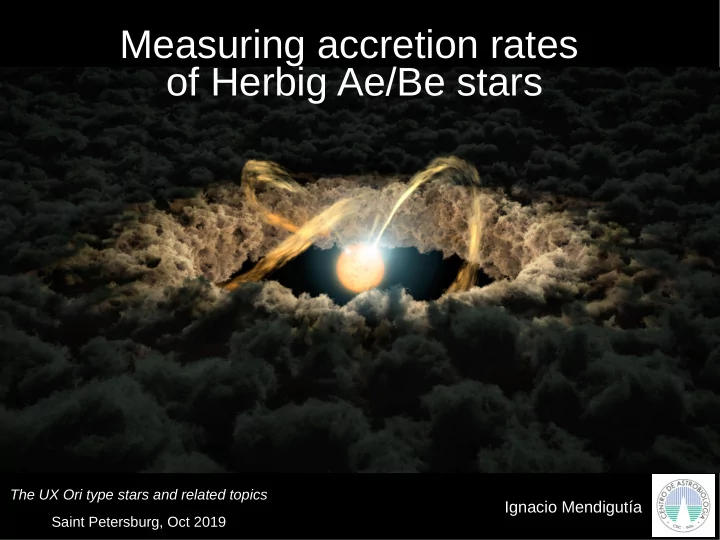

Measuring accretion rates of Herbig Ae/Be stars The UX Ori type stars and related topics Ignacio Mendigutía Saint Petersburg, Oct 2019
Why accretion? Hartmann (2009) - Ṁ acc traces the evolution of YSOs (Hartmann+1998; Fedele+2010, Sicilia-Aguilar+2010...) - Ṁ acc probes the gas reservoir --> Alternative M disk (Hartmann+1998; Dong+2018….) - Ṁ acc is an input parameter necessary for detailed disk modelling (e.g Woitke+2016) - Inferring Ṁ acc requires understanding the physics of the star-disk interface
Does magnetospheric accretion (MA) also work in HAeBes? 5/6 x Ṁ acc B field ~ M * 1/2 x v rot* -7/6 x R * -11/6 (e.g. Johns-Krull+99) TTs need kG, HAeBes need ≤ 100 x G Small B field → small disk truncation radius (~ 5R * for TTs; ~ 2.5R * for HAeBes) Nn Boundary Layer (BL) Earliest suggestions that MA could work at least in HAes (not in HBes): Vink+(2002); Eisner+(2004)
First MA characterization of a HAeBe star: UX Ori (Muzerolle et al. 2004) Calibration valid only for UX Ori! Accretion rates can be inferred from spectral line and accretion shock (ΔD B ) modelling (see also Calvet+2004; Garcia-Lopez+2006 for IMTTs)
First systematic MA estimates for HAeBe stars Mendigutía et al. 2011: M acc for 38 northern HAe(Bes); ~ 10 -7 M ⊙ /yr , but depends on M * Depends on the star! ΔD B <±0.5 dex accuracy HAeBes HAeBes HAeBes ±1 dex accuracy TTs TTs TTs (see also Donehew & Brittain 2011, Pogodin+2011)
Invalid accretion tracers for HAeBe stars (Mendigutía et al. 2011, 2013) ΔD B RR Tau L Hα HAeBes HK Ori ΔD B = K L Hα TTs Hα 10% width valid for TTs (Natta+2004), Accretion & line variabilities decoupled! → not for HAeBes (large v sini ). Careful spectro-photometric monitoring needed First suggested by Boley+2009 for a HBe star. (e.g. Dupree+2012, 2013) Same for spectroscopic line veiling (Muzerolle+ 2004: T shock ~ T * ~ 10000 K)
More recent MA estimates for HAeBes Fairlamb et al. 2015: Ṁ acc for 91 southern HAeBes from ΔD B modelling based on X-Shooter spectra → stellar parameters Fairlamb et al. (2017): L acc from ΔD B and L line from X-Shooter spectra ( TTs, Alcalá+2014; HAeBes, Fairlamb+2015 ) Optical/Near-IR Near-UV/Optical Near-IR ⊙ log L acc /L log L line /L ⊙ log L acc /L ⊙ = A + B x log L line /L ⊙ (~ ±1 dex accuracy) All emission line luminosities serve to estimate accretion rates...
...but not all emission lines probe accretion 1) Accretion variability (from ΔD B ) generally decoupled from simultaneous spectral line variations 2) The main Brγ & Hα emitting regions are larger than the accreting region in many HAeBes (Kraus+2008; Garcia Lopez+2015, 2016; Mendigutía+2015, 2017; Tambovtseva+2016; Kurosawa+2016; Kreplin+2018...) 3) The physical origin of some lines is not related to accretion (e.g. [OI]6300 comes from the disk in HAeBes, Acke +2005; Acke & van den Ancker 2006)
Caution: L acc correlates with L line regardless of its physical origin, because of the correlation with L * (Mendigutía et al. 2015) L acc -L star L acc -L line ...Thus, L * can also be used to estimate L acc (~ ±1 dex accuracy)
Present and future: Gaia Gaia distances to re-determine stellar parameters of HAeBes: > 200 known to date (Vioque+2018), and increasing (Vioque+, in prep.) Arun et al. (2019): Ṁ acc for 106 HAeBes from L Hα (and increasing; 163 HAeBes from L Hα in Wichittanakom+, poster 10 ) Guzmán-Díaz+, in prep: homogeneous stellar parameters from SED fitting , M disk , M acc ...for 221 HAeBes Salpeter’s IMF <--IMTTs MYSOs-->
MA works in HAes MA does not work in HAes - Statistics on spectral lines (Cauley & - Reiter+2018 (HeI10830 similar in 5 magnetic Johns-Krull 2015, 2014) and 59 non-magnetic HAeBes) - Multi-epoch spectra (Schoeller+2019, 2016; - Aarnio+2017 (multi-epoch 1 HBe + 1 HAe) Costigan+2014; Mendigutía+2011a) - Blondel & Tjin A Djie 2006 ( Ṁ acc from BL for - Spatially-resolved (Eisner+2010, 2004) 39 F & A stars) - Line/shock modelling (Tambovtseva+2016; Fairlamb+2015; Mendigutía+2011b; Muzerolle+2004...) - Spectro-polarimetry (Ababakr+2017; Mottram+2007, Vink+2002, 2003, 2005) - ... What if MA estimates are wrong? Blondel & Tjin A Djie 2006 Preliminary test MA and BL estimates of HAe stars differ ≤ ± 1 dex (best case scenario) In general Ṁ acc (BL) > Ṁ acc (MA) Fairlamb+2015 & Mendigutía+2011
HAes and HBes behave differently (e.g. Oudmaijer, SFNewsletter, Jan 2019), moreover: MA does not work in several HBe stars Mendigutía+(2011) and Fairlamb+(2015) identified > 20 HBes for which MA shock modelling hardly reproduces the observed ΔD B (covering fractions ≥ 50-100%) “Non-magnetospheric” HBes VY Mon R Mon BL? PDS 133 HD 85567 HD 305298 DG Cir HD 141926 VV Ser LkHa 234 HD 53367 V380 Ori V590 Mon GU Cma Z Cma (A4) PDS 27 PDS 281 PDS 286 PDS 37 HD 94509 HD 96042 PDS 69 MWC 297 AS 442
Work in progress 1) GRAVITY/VLTI data of 6 “non-magnetospheric” HBe stars under analysis (Marcos-Arenal+, in prep.) Flux HD 94509, Herbig Be, 12000 K, 11M ⊙ λ/2B ~ 2 mas, R ~ 4000, 4 UTs Diff phase Vis² 2) UV spectra could be key to disentangle between MA and BL (IUE, Hubble, WSO...) BL MA BL
Conclusions - Ṁ acc is not a direct observation → needs an underlying model. - Numerous indications suggesting that MA is valid for HAes and some HBes (but not yet a consensus) - MA estimates: Ṁ acc ~ 10 -7 M ⊙ /yr (dependence on M * ). * Accuracy < ± 0.5 dex from direct estimates (near-UV excess) * Accuracy ~ ± 1 dex from indirect estimates (correlations with L line or L * ) * Emission line modelling strongly depends on relatively free parameters - Ṁ acc (BL) scarce but ≥ Ṁ acc (MA) for HAes - Alternatives to reproduce near-UV excess of several HBes: BL?; other accretion scenarios? (e.g. Takasao+2018); winds?
Recommend
More recommend